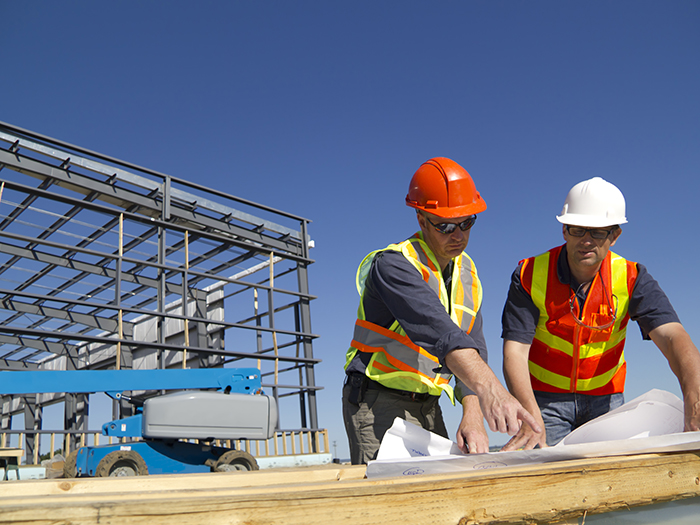Beyond Insurance, Risk Management Helps Resolve Supply-Chain Challenges in Construction

While labor and safety issues will probably remain the top concern in the construction sector for some time to come, supply chain issues will never be too far behind.
“Insureds at all levels are dealing with supply-chain complications, interest rate changes, and price escalation as well as limited availability of energy, labor, and materials,” said Amelia Valz, senior vice president of construction specialties at Arch Insurance.
That being said, insurance is there to ease the bumps in the road and capacity should not be an issue.
Arch has been steadily expanding its construction book of business for several years. The focus is on non-residential, commercial from specialty trade contractors to large GCs. Sub-contractor default is one of the biggest segments of construction specialty coverage for Arch.
“We insure commercial general contractors for the risk they assume for subcontractor performance,” she noted. “We can provide ways for both to level up through frequently updating the process for subcontractor qualification. General contractors [GCs] are used to laying off risk onto the subs, but the GCs have come to realize that issues with the subs has a ripple effect in the project.”
Lenders are big drivers in determining the coverages and limits of insurance purchased for a project,” said Valz. “We don’t insure lenders directly but their requirements are definitely a factor in coverage we do write.”
For casualty coverage “there is sufficient overall capacity and potential softening for commercial/not-for-sale construction projects,” said Ben Dorweiler, director of construction at brokerage Trucordia. “Reasons for that include added capacity via the non-admitted market, which can be explained by a combination of MGAs, appetite changes and market shift to write what has historically been a more profitable sector of the business.”
The valuation of projects for construction managers “is an incredibly challenging,” Dorweiler explained, because “many of these projects span many years, it is impossible to incorporate market changes within those parameters prior to the start of construction. No one can predict potential disruptions in the supply chain, a spike in energy costs or a geopolitical risk. All brokers can do is provide market insight, the cost of the insurance at time of construction, and make updates as necessary.”
Specific to the supply chain, Valz, at Arch, noted that “contractors have taken big leaps since Covid. During the pandemic everything suddenly became more critical and they had to start monitoring everything, whether it was directly their responsibility or not. Project owners and managers have always had a ‘critical path’ for key components and milestones. But, eventually, everything becomes critical because you can’t finish the project without [all the elements].”
For major setbacks there is delay-in-startup coverage. “And builders risk has an option for delay-in-completion coverage,” Valz added. “Professional liability can have delay components as can subcontractor default insurance. One important part of contractual language is the right to recover actual damages and liquidated damages.”
In terms of technology, construction is not known as an early adopting sector, but Valz said that “insureds are driving tech, for example, some are testing RFID tags on components, such as each piece of glass for a curtain wall.”
As project owners and contractors face headwinds in supply-chain and logistics bottlenecks,” “part of the problem is lack of visibility, or poor communications” among suppliers, transporters, builders, and owners said Derek Patrizio, chief underwriting officer, and head of construction middle market at Liberty Mutual. “That is why relationships matter. Of course diversifying sources of supply can help mitigate disruptions, but not every component has multiple suppliers. Just-in-time planning has evolved to just-in-case planning.”
Liberty Mutual writes from the larger end of the construction market where contractors may elect loss-sensitive programs or wraps, through the middle market where the risk tolerance varies based on operations and scope of work.
Technology can help. Patrizio noted that increasingly sophisticated procurement software can help contractors track materials, and block chains add transparency to contracts and other agreements. “Tying into any software insureds are using to manage supply chains, lets us make recommendations to help overall efficiency.”
As part of mitigation Liberty Mutual coordinates risk-management and claims-control meetings among insureds, brokers, underwriters, and risk managers. “We call them stewardship meetings,” said Patrizio. “All parties get and give project updates, review plans, and collaborate on any midcourse corrections.”
For any contractor or owner eager to participate in the energy transition, “insurance will be a major enabler,” said Cheri Hanes, head of construction innovation and sustainability AXA-XL. “Sustainability is a major focus. Writ large, the question is, how does the project affect the planet? Within the project itself we have created a benchmarking process for sustainable building practices.”
AXA-XL writes five main lines in construction: default, builders risk, professional and pollution, primary, and excess. To help contractors evaluate their sustainable building practices against their industry peers, AXA XL launched its Sustainable Building Practices Adoption Maturity Index benchmarking service early in January.
“Projects are very vulnerable in the supply chain,” said Hanes. “The sooner you lock in your materials, labor, and services the better. Whether the owner or the contractor or the subs are ordering, score it, put it on the list, put someone in charge of it. Especially if there is a sole source. Know what the alternative sources or materials are.”
One technique that has become common in large projects, especially for high-demand or long lead-time components, is to order extra early – even a year or more – and stage the goods near the job site. Secure storage is an extra cost, but is usually small compared to any potential delay in the project for late delivery or worse, non availability.
Reflecting on the disruptions during the pandemic, Hanes stated, “Covid did not cause most of that, it merely exposed the weaknesses.”
She also stressed that “cyber risk is an emerging threat to the supply chain. Vendor vulnerabilities to cyber attack can be serious. Part of supply-chain risk management is to evaluate vendors and suppliers for cyber security.”
Overall Hanes is confident that the cost of risk can be quantified accurately, even with all the variables in construction projects and their varied supply chains. “We want to get it right. Not too high or too low. We want to get it right in a comprehensive way. The fact that we have someone in a position like mine is an advantage. We write coverage on an a-la-carte basis, but we do have clients who use all five of our lines. They usually come for one and then expand into others.”
Artificial intelligence and machine learning “are revolutionizing the US construction industry by automating repetitive tasks, aiding in design and planning, and enhancing safety through site monitoring and predictive maintenance,” said David DeSilva, head of construction at The Hartford.
“AI will also play a crucial role in designing energy-efficient buildings,” he added. “Despite the variability in projects, loss analysis using AI can identify patterns, improve forecasts, and optimize processes. In terms of safety and risk management, AI-powered systems analyze images from construction sites to detect safety hazards and quality issues, improving overall site safety. For project management, AI optimizes resource allocation by predicting project timelines and identifying potential delays, and enhances supply chain predictability, helping manage materials and logistics more efficiently.”
The main types of insurance policies The Hartford provides for the construction industry include: workers comp, general liability, commercial auto, umbrella, builder’s risk, professional and pollution liability, as well as wrap coverage and inland marine to cover tools and materials in transit. &












